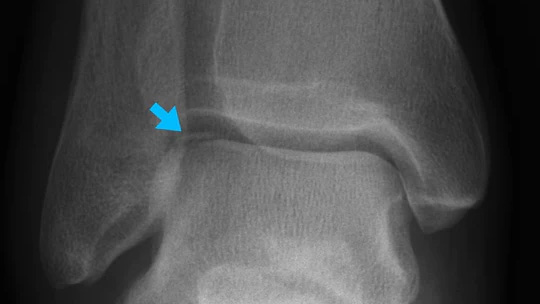Talar Dome Fracture
The Talus bone is the highest bone in your ankle and connects to your leg’s Tibia and Fibula bones. The Talus bone is vital when it comes to movement and balance. The sites where the top of the Talus bone connects to the Tibia and Fibula bone are referred to as the Talar Dome. The top of the Talus bone is covered in a rubbery substance called cartilage. This protects the bones from scraping together and causing pain. The cartilage also makes sure your ankle joint moves smoothly. Complications arise when the force of a blow damages the bone under the cartilage. As time passes the injured bone may collapse under the cartilage and over time can detach, float away, and become stuck in the ankle joint.
WHAT CAUSES A TALAR DOME FRACTURE?
A Talar Done Fracture occurs by:
- Direct trauma to the Talus bone and cartilage
- Rolling your ankle
HOW DO I KNOW IF I HAVE A TALAR DOME FRACTURE?
WHAT ARE THE SYMPTOMS OF A TALAR DOME FRACTURE?
- Ankle joint locking
- A clicking or grinding sensation in the joint
- Weak or instable ankle joint
- Deep set ankle pain
- Inflamed ankle joint
- Pain during physical activities such as walking or running
HOW IS A TALAR DOME FRACTURE DIAGNOSED?
- Physical examination
- MRI
- Bone scan
WHAT CAN I DO FROM HOME FOR A TALAR DOME FRACTURE?
WHAT CAN I DO TO PREVENT A TALAR DOME FRACTURE?
- Avoid extreme sports
- Avoid landing on the foot heavily
WHAT TREATMENTS CAN I DO FROM HOME FOR A TALAR DOME FRACTURE?
- REST – Get off your injured foot as soon as possible. Relieving weight and pressure will help your foot heal faster and avoid further injury. Keep the weight off of the foot for four to ten weeks. Use of crutches and walking boot is recommended.
WHEN SHOULD I SEE A DOCTOR FOR A TALAR DOME FRACTURE?
Talar Dome Fractures are often misdiagnosed as Ankle Sprains so make sure you visit your doctor if you continue to feel deep-set ankle pain even after the initial pain has subsided.
TREATMENTS YOUR DOCTOR MAY RECOMMEND FOR A TALAR DOME FRACTURE
Non-Surgical:
- Rest – Get off your injured foot as soon as possible. Relieving weight and pressure will help your foot heal faster and avoid further injury. Keep the weight off of the foot for four to ten weeks. Use of crutches if recommended.
- Ice – Rest or wrap your injured foot with ice as soon as possible. Ice helps prevent swelling and promotes faster healing time. Wrap the ice in a towel and avoid putting ice directly on the skin.
- Compress – Immobilize the injured foot with a bandage or ankle brace. This gives your ankle stability and protects it from further injury. Make sure you don’t wrap your foot or ankle too tightly. You don’t want to cut off the blood supply to your foot.
- Elevate – Make sure you keep your foot elevated as this will also help to minimize swelling. It’s best if you can elevate your foot to the level of your heart.
Surgical:
Your doctor will make a small incision in your foot, remove the chip that may be floating in your ankle, and smooth out the rough spot on your Talus bone. If the chip or hole is too big your doctor may take cartilage from somewhere else and transplant it into the hole.

